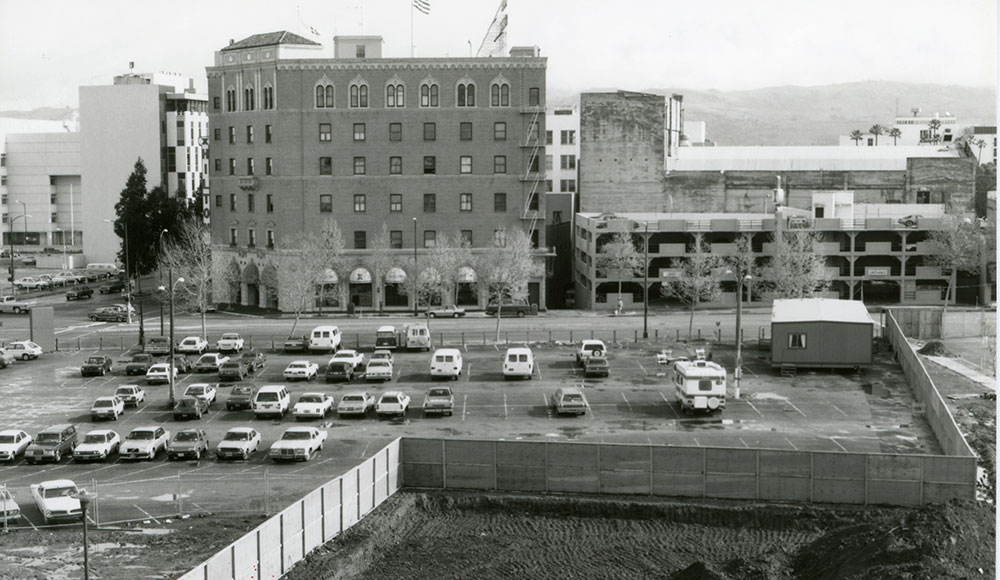Only in San Jose would a long-vanquished parking lot summon the ghosts of Ernest Tubb, Iron Maiden and the Dead Kennedys.
Back in the ’80s, right as the San Jose McEnery Convention Center was coming into being, the slab of concrete at the southwest corner of Market and San Carlos was the greatest heavy metal parking lot in San Jose history. Before any concert at the San Jose Civic Auditorium—you know, like Saxon, Dio, Accept, Iron Maiden or even punk shows with their own riots—this parking lot was the prime drinking spot for many fans on their way to the shows. San Francisco had the Cow Palace parking lot. Oakland had the coliseum parking lot. This lot at Market and San Carlos was San Jose’s equivalent.
As I look at an old photo, the ghosts emerge. And they are ornery.
In the photo, I can stare directly across the Pintos, Datsuns and Chrysler K cars, right at the St. Claire Hotel, where the Dead Kennedys played in 1981. I did not attend that show, but in those days, the Sainte Claire was not the posh gem it is today. Nor was the Civic.
As I continue to raise the ghosts, I cannot separate that parking lot from beater Chevy Novas with mismatched doors, 99-cent Lynyrd Skynyrd coke mirrors from the flea market, denim jackets with puffy collars, and trails of Burgie cans along the sidewalk. The gods are stalking the concrete.
Dead parking lots contain all sorts of stories. As Rebecca Solnit wrote in A Field Guide to Getting Lost, “The places in which any significant event occurred become embedded with some of that emotion, and so to recover the emotion, and sometimes to revisit the place uncovers the emotion. Every love has its landscape.”
She was primarily referring to country songs, in which the narrator told a heartbreaking story, and how the effects of the landscape—the geography—lingered like ghostly spirits, inseparable from the events themselves.
Newspaper columns can function in the same way.
“Place, which is always spoken of as though it only counts when you’re present, possesses you in its absence, takes on another life as a sense of place, a summoning in the imagination with all the atmospheric effect and association of a powerful emotion,” Solnit wrote.
As such, I cannot separate this particular parking lot from the long-gone spirits of what used to exist along that street before the convention center wiped it all out. A fantastic art gallery, for example, the Young Gallery, existed right across from the Civic Auditorium. Thanks to the convention center, it was driven out of town to Saratoga.
Going back even further, a notorious country and western bar, Hat’s Club, sat right there too. A 1963 ad mentions a gig by the legendary Ernest Tubb billed as, “the country and western event of the season.” Cottonseed Clark hosted the evening. When old-timers recall San Jose being a cowtown, they’re not exaggerating. Many people wish it still was a cowtown, although I tend to avoid those people.
Decades later, in 1986, when Orange County punk legends the Adolescents were scheduled to headline a huge show at the Civic Auditorium, a riot broke out. People ripped tiles out of the floor. One police officer was injured and 10 people received citations. World-famous skateboarders still tell stories about that night.
Why? Because every love has its landscape.
“The places inside matter as much as the ones outside,” Solnit wrote. “It is as though in the way places stay with you and that you long for them they become deities—a lot of religions have local deities, presiding spirits, geniuses of the place.”
To paraphrase Solnit even more, in these newspaper columns of mine, rundown parking lots, half-demolished buildings and abandoned structures are all spirits conjured by the columnist. Perhaps I am indeed suffering from a bout of serious longing—longing for the dreamtime before I was banished away, back when I lived among the gods, who were not phantasms, but, instead, geography, matter and earth itself, as Solnit wrote. In San Jose, the landscape has remained, attached to emotions of the events it carried. It is living history.
Who needs a convention center anyway?



